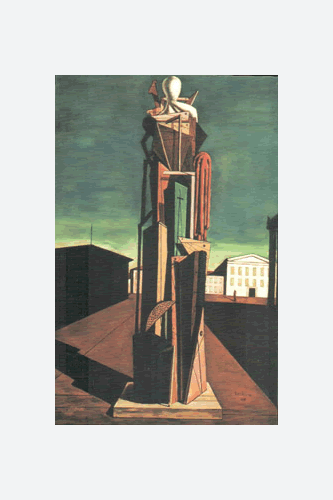 à àBeyond realism |
|
|
Style of painting that flourished mainly between 1911 and 1920 in the works of the Italian artists Giorgio De Chirico, Carlo Carrà, and Giorgio Morandi. These painters' representational but bizarre and incongruous imagery produces strange, disquieting effects on the viewer. Juxtaposing disparate objects set into deep perspectives, these works strongly influenced the Surrealists in the 1920s. Metaphysical painting originated with De Chirico. In Munich, where he spent his youthful formative years, De Chirico was attracted to 19th-century German Romantic painting and to the works of the philosophers Arthur Schopenhauer and Friedrich Nietzsche. The latter's search for hidden meanings beyond surface appearances and his descriptions of empty squares surrounded by arcaded buildings in the Italian city of Turin made a particularly deep impression on De Chirico; his 1915 painting "Turin Melancholy" (Carlo Frua de Angeli Collection, Milan), for example, illustrates just such a square, with unnaturally sharp contrasts of light and shadow that lend an aura of poignant but vaguely threatening mystery to the scene. The arcades in this painting, as well as the deep perspectival space and dark-toned sky, are pictorial devices found in many of De Chirico's strange, evocative works. The enigmatic titles of his paintings contribute to their dreamlike effect: "The Nostalgia of the Infinite" (Museum of Modern Art, New York City), "The Philosopher's Conquest" (Art Institute of Chicago), and "The Soothsayer's Recompense" (Philadelphia Museum of Art). Many of De Chirico's paintings depict mannequins, as do the works done around 1917-21 by the former Futurist Carlo Carrà, who came under his influence. The two artists met in 1917, in Ferrara where, together with De Chirico's younger brother--a poet, musician, and painter known as Alberto Savinio--they formulated the rather obscure principles of the scuola metafisica (Metaphysical school). De Chirico, however, had already arrived at his Metaphysical style several years before the movement came into existence and, by 1911, had shown paintings of this nature in Paris. Other adherents to Metaphysical painting were Filippo de Pisis and Mario Sironi. The Metaphysical school proved short-lived, however, and came to an end around 1920 because of dissension between De Chirico and Carrà over who had founded the group. De Chirico's work done after 1919 lost much of its mysterious power and eventually sank into a degraded and eccentric classicism.
Pittura Metafisica [Arte Metafisica] Term applied to the work of GIORGIO DE CHIRICO and CARLO CARRÀ before and during World War I and thereafter to the works produced by the Italian artists who grouped around them. Pittura Metafisica was characterized by a recognizable iconography: a fictive space was created in the painting, modelled on illusionistic one-point perspective but deliberately subverted. In de Chirico’s paintings this established disturbingly deep city squares, bordered by receding arcades and distant brick walls; or claustrophobic interiors, with steeply rising floors. Within these spaces classical statues and, most typically, metaphysical mannequins (derived from tailors’ dummies) provided a featureless and expressionless, surrogate human presence. Balls, colored toys and unidentifiable solids, plaster moulds, geometrical instruments, military regalia and small realistic paintings were juxtaposed on exterior platforms or in crowded interiors and, particularly in Carrà’s work, included alongside the mannequins. In the best paintings these elements were combined to give a disconcerting image of reality and to capture the disquieting nature of the everyday. |
 |
Email : info@metarealism.com http://www.alternative-psychology.com
|